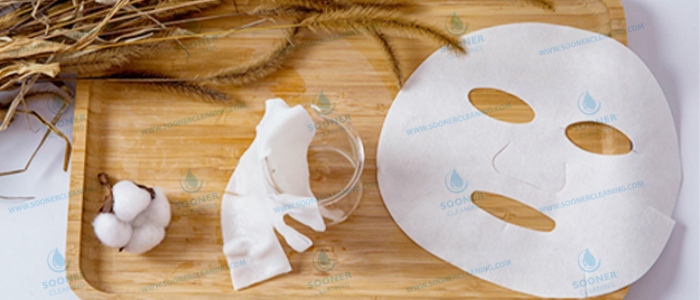Home>News
What are the materials for facial mask base cloth? The most complete summary in 2024
- 2024-08-23
As people's living standards gradually improve and their demand for beauty care increases, facial mask products have become daily skin care products for many consumers. Therefore, the facial mask industry has developed rapidly in recent years, and the market size has exceeded 10 billion yuan. The facial mask market will still have large room for growth in the future. According to product form, the masks sold on the market mainly include facial masks, cream (milk) masks, gel masks and powder masks. Facial masks, also known as sticker masks, are most popular with consumers because of their advantages such as easy use, easy carrying and long shelf life. At present, this type of product accounts for about 80% of the mask market share, with an annual consumption of more than 1 billion pieces.

Facial mask base fabric raw materials
In the composition of the facial mask, the facial mask base fabric serves as a carrier for high-concentration essence or nutrient solution and has strong liquid-absorbing and fixing properties. Most facial mask base fabrics on the market use cotton fiber, regenerated cellulose fiber, silk fiber, etc. as the main raw materials. There are also mixed fibers of different materials such as chemical fiber and plant fiber.
Cotton fiber is 100% pure natural fiber and is less irritating to the skin. It is widely used in facial mask base fabrics. However, a mask made entirely of cotton fiber does not fit the face well, and the essence in the mask is easy to drip.
Regenerated cellulose fiber uses natural cellulose as raw material. Through physical and chemical means, it changes the physical structure of natural cellulose and improves the hygroscopicity and breathability of the fiber. It is known as the "breathing fabric"; in the facial mask base fabric The more common regenerated cellulose fibers include viscose fiber, Tencel fiber and cupro fiber, which can improve the liquid carrying capacity, softness and comfort of the surface, and are cost-effective.
Silk fiber is mainly composed of silk protein and contains a variety of amino acid components. It has strong affinity and silkiness to the skin, but it is relatively expensive and has low physical strength. When mixed with other fibers, it can improve the facial mask sheet quality.
In addition to the above-mentioned main fibers, auxiliary fibers (polyester fiber (PET), polypropylene fiber (PP) and other synthetic fibers) and functional fibers (chitosan fiber, seaweed fiber, bamboo carbon fiber, nanocellulose fiber, bacteria Cellulose fiber, etc.) is also the current research hotspot and exploration direction in the facial mask base fabric industry, which is used to further improve the antibacterial properties, liquid holding capacity, air permeability, moisture permeability and facial fit of the facial mask base fabric, making the mask more Thin and transparent, it even has a transparent and invisible effect.
Facial mask base fabric production process
The weight of facial mask base cloth is generally in the range of 40 to 50 gsm. The production process usually adopts the spunlace nonwoven method, that is, the fiber raw materials are mixed and opened, carded, cross-laid, drafted, pre-wetted, spunlace reinforced, and hot-rolled , drying and rolling to prepare the facial mask base cloth.
The characteristic of the spunlace process is to use high-pressure water needles to puncture the fiber web, so that the fibers are fully entangled and flocculated, thereby improving the physical strength of the beauty facial mask sheet base fabric. This process does not require the use of chemical adhesives for reinforcement, so the product is more environmentally friendly than the dry production process of non-woven fabrics.
Spunlace products also have the advantages of soft feel, good drape, and close to traditional textiles.
Based on the traditional spunlace base fabric production process, cotton linters are dissolved into a cellulose solution, which is then extruded from a porous mold, spun, and then passed through processes such as filament fiber laying, spunlace reinforcement, and drying. Finally, a wet spunbond facial mask base fabric is formed. This technology realizes one-time molding from raw materials to products, with high production efficiency.
Moreover, the facial mask base fabric can absorb more than 10 times its own weight of liquid and has strong liquid holding capacity. The combination of electrospinning and spunlace technology can effectively control the fineness of the fiber and develop a new facial mask base fabric that is thinner, has good fit, and has high hygroscopicity and water retention.
If you want to know more about beauty facial mask sheet fabric, please contact us. Soonercleaning provides you with customized solutions and free samples.
E-mail: info@soonercleaning.com
Skype: +86 13810146753
- Previous article:Biodegradable Wipes
- Next article:What are the applications of spunlace nonwoven wiping materials?











